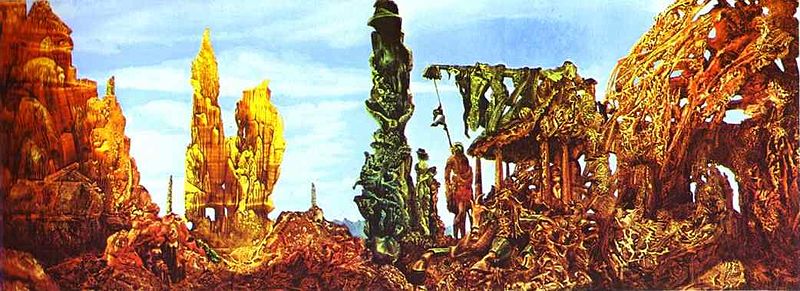The opening of “The Real Cape Kennedy Is Inside Your Head,” a Dylan Trigg meditation in 3:AM Magazine about J.G. Ballard’s “Cape Canaveral” stories:
Against a saturated blue sky, a landscape is in a state of decomposition. Semi-gelatinous material entwines with desiccated chunks of a destroyed world. Towering shafts of ruined debris shoot haphazardly into the sky, forming a monolithic domelike structure in the process. A cow—or its head—appears trapped in the rubble, its body colonised by the ruins. Into this zone of mutilation, two figures, a man and a woman, stand adrift. They enter the field of our horizon and then remain motionless in the ruins. The woman is dressed elegantly, her back turned to the viewer, her body in motion. Turning toward her, a man with the skull of a bird looks on passively. Whether or not they were caught in the destruction or have returned to survey the remains, the viewer cannot be sure. In each case, they are no longer recognisable as “human” and instead have begun assuming the physiognomic characteristics of the landscape. Like the cow, their bodies are in a state of atrophy, their tones now mirroring the colouring of the landscape. Everywhere, borders collapse. What looks like the remains of a civilization may also be the inception of a new world. Similarly, if there are humans in the ruins, then they might just as easily be a new species of life, composed from both the organic and synthetic waste left behind. In the rot and the ruin, there is also life and vitality, a bewildering fusion of different orders of space and time colliding in the same sphere.
We are in the world of Max Ernst’s celebrated painting, Europe After the Rain II. Painted between 1940-1942, the work has become canonised as a masterpiece in the surrealist tradition. For J.G. Ballard, the landscapes of Max Ernst assumed a particular importance in his own thinking and writing. Above all else, what Ballard was able to discover in Ernst’s visions was a symbiosis of the natural and the supernatural, the banal and the uncanny, all of which begin not in the objective features of the landscape, but in the pathology of inner space. In his words, Ernst’s world took the form of “self-devouring phantasmagoric jungles [which] screamed silently to itself, like the sump of some insane unconscious.” Like the German romantics who influenced him, Ernst’s eerie forests and organic cities are emblems of the inner working of the deep unconscious manifest—as though by accident—on the canvas of the work. In Ballard, the same process of alchemically distilling disjoined images from the prima materia of everyday life finds its strange expression in his repetition of motifs. Abandoned parking lots, empty swimming pools, and neon nightclubs glowing in the thick forests of night all assume a level of spectral significance made possible thanks to the conjunction of inner and outer space.
Nowhere is this strange union between inner and outer space clearer than in Ballard’s “Cape Canaveral” stories, which are scattered through his writing from the early 1960s to the 1990s. In these stories, Ballard plays with themes of spatio-temporal distortion resulting from the flight into cosmic space. At once a warning against cosmic misadventures, the stories can also be read as an affirmation of humanity’s transformation the misadventures entail, as he states:
By leaving his planet and setting off into outer space man had committed an evolutionary crime, a breach of the rules governing his tenancy of the universe, and of the laws of time and space. Perhaps the right to travel through space belonged to another order of beings, but his crime was being punished just as surely as would be any attempt to ignore the laws of gravity.•
Tags: Dylan Trigg, J.G. Ballard


